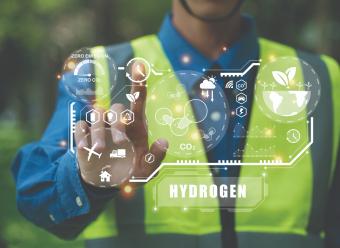Characterization work aims to address cost of green hydrogen technologies


By Emilie Rusch, Special to Mines Research Magazine
The appeal of green hydrogen is clear, but before hydrogen fuel cell and electrolyzer technologies can be adopted on a commercial scale, questions of cost, durability and performance still need to be addressed.
Svitlana Pylypenko, associate professor of chemistry, is looking for answers at the microscopic — and even nano — scale.
In collaborations with partners in industry, nationallaboratories and academia, Pylypenko is leading cutting-edge characterization work to improve understanding of low-temperature polymer electrolyte membrane (PEM) water electrolyzers and fuel cells, two leading technologies for green hydrogen production at scale and hydrogen conversion to electricity.

For fuel cells, work on fabricating high-performance electrodes and understanding the complex relationships between various fabrication and processing parameters, the resulting electrode’s structural properties and the electrochemical performance is well underway. Pylypenko’s partners include the University of Connecticut, the U.S. Department of Energy’s National Renewable Energy Laboratory (NREL), Germany’s Fraunhofer Institute for Solar Energy Systems, Pajarito Powder and Forge Nano.
Additionally, the team also hopes to accelerate the development of high-volume fabrication of catalysts with tunable properties for a wide variety of applications. “When our industrial partner makes a new catalyst, they might have clients that want to purchase that catalyst for a different application, and they need to know how that catalyst will perform under those different applications,” Pylypenko said.“ Understanding those structure-processing-performance relationships is important.”
On the electrolyzer side of the equation, Pylypenko is collaborating with NREL as part of Hydrogen for Next-generation Electrolyzers of Water (H2NEW), a consortium of nine DOE national laboratories focused on making large-scale electrolyzers more durable, efficient and affordable. With a focus on both low- and high-temperature technologies, H2NEW’s goal is to achieve the required cost, durability and performance targets to enable $2-per-kilogram green hydrogen by 2025.
“Expensive catalysts weren’t an issue before — as long as the electrolyzer performed under certain conditions and produced hydrogen, it was OK to be expensive,” Pylypenko said. “But now that our community is trying to scale these technologies up, we need to reduce cost and use cheaper components when possible and make sure they are reliable for many, many years.”
Mines is home to multiple research facilities available for this type of characterization work, including the Pylypenko Research Group lab, and user facilities, such as the Multiscale Materials Characterization Facility in the CoorsTek Center forApplied Science and Engineering, which has several unique tools for advanced characterization.
“If we want to address global warming, we need to do everything — we need to do solar, we need to do wind, we need to do fuel cells, we need to do electrolysis and multiple types of electrolysis, because they all will have different niches,” Pylypenko said. “If you want to address the issue globally, we also have to think about how a device will work in the U.S. versus a device working in another country, because of the different contaminants in the air and humidity levels. And that’s where there is still a lot of work to do.”



